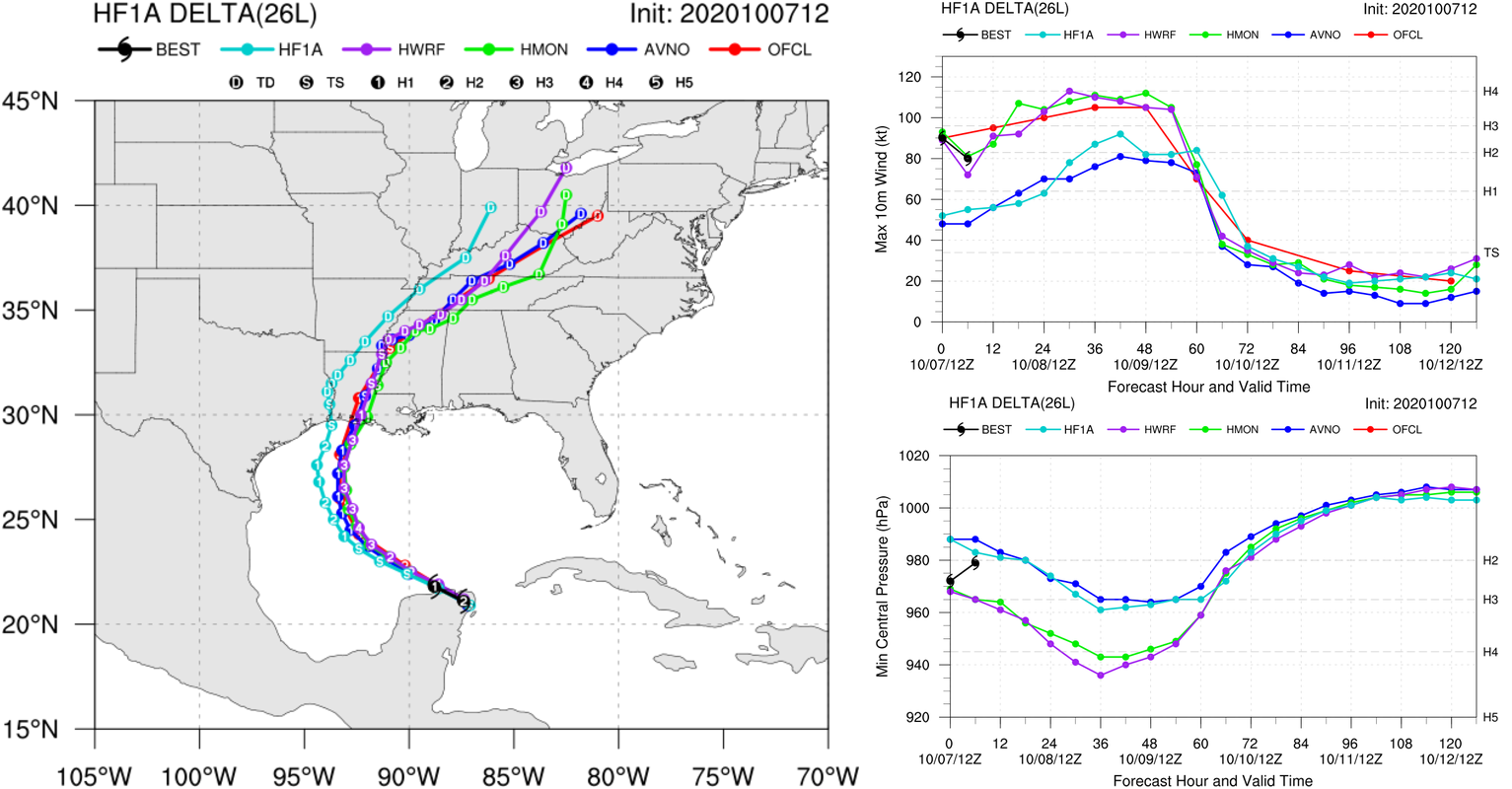-
RUCOOL Updates: February – March 2021
Posted on April 16th, 2021 No commentsThe spring semester is well underway as the team works on numerous research proposals for the coming year with April deadlines. We are all looking forward to the spring warming and the fully loaded summer field season ahead.
State
- In support of the SEBS Virtual Learning Experience, Josh Kohut discussed offshore wind energy development in the Mid-Atlantic Bight, the important environmental considerations, how it will affect our ocean and planet in the short and long terms, and how Rutgers is involved in delivering high tech ocean solutions to the development of this state-of-the-art industry to the U.S.
- Mike Crowley, as Technical Director of RUCOOL and the Mid Atlantic Regional Association Coastal Ocean Observing System (MARACOOS), represented MARACOOS and Rutgers on capitol hill visits with the offices of Senator Cory Booker, Rep. Mikie Sherrill, Rep. Frank Pallone and Rep. Chris Smith. Discussions focused on RUCOOL contributions to NWS tropical storm forecasting, NOAA fisheries bycatch mitigation, NJ offshore wind development and mitigating interference with right whale migrations during turbine installations, NJDEP water quality monitoring and K-16 education.
- The RUCOOL ECO-PAM glider project with Orsted’s Ocean Wind project completed its fourth scheduled deployment off of New Jersey. Detections of the endangered North Atlantic Right Whale coincided with an oceanic front towards the edge of the continental shelf detected via satellite sea surface temperature and RUCOOL high frequency radar surface currents, an interesting and first-time finding. Glider deployments will resume this fall.
- Late winter is usually a quiet time for the mid-Atlantic glider deployments, but this February and March we supported 5 deployments of gliders in the NY Bight that are doing water quality research for NJDEP, ocean acidification monitoring for NOAA, and tracking right whale migrations off of Atlantic City for Orsted. It promises to be a busy glider year ahead.
- Operational Oceanography students have finally been able to participate in covid-safe field work through a return to research, gaining valuable hands-on experience in the field! Students are in the final stages of submitting their project abstracts to the student poster competition at the Marine Technology Society OCEANS conference, learning to effectively communicate their science.
- Grace Saba presented an invited talk entitled “Ocean and Coastal Acidification in the Mid-Atlantic: The What, the Why, and the Risks” for the Hooked on Ocean Acidification Mini-Series sponsored by the Mid-Atlantic Coastal Acidification Network (MACAN) and MARACOOS.
- RU COOL faculty continue teaching seven courses including Oceanography Seminar, Topics in Marine Science, Operational Ocean Modeling, Polar Systems, Integrated Ocean Observations 2, Science Pseudoscience and Society, and Field Laboratory Methods 2.
- During this semester, RUCOOL faculty are working with 8 interns including George H. Cook Honors students Noah Motz, Christina Schultz, Mollie Passacantando and Marissa Guzik, SEBS Honors students Miah Manning and Emma Huntzinger, and EBE students Kiernan Bates and Aviva Lerman.
National
- Brad Colman, a meteorologist with the Climate Corporation, and Scott Glenn, an oceanographer from Rutgers University, have been selected by the NOAA Science Advisory Board to co-lead the Priorities for Weather Research (PWR) Report to Congress (RtC) due in December of 2021. They will assemble and lead a group from across the Weather Enterprise that will recommend priorities for the next decade of Congressional investments in observations & data assimilation, forecasting, and information delivery to improve weather forecasts and warnings through an Earth Systems, Social, and Behavioral Sciences approach.
- The education and outreach team was involved with numerous activities including serving as a judge in the Youth Institute, acting as a rules judge in the 2021 Shore Bowl, teaching a Broader Impacts class on effective partnerships for the ARIS Center (Advancing Research Impacts in Society), and serving as panelists for the OOI re-siting of the Pioneer Array meeting, Additionally, the education team had 3 New Brunswick HS students selected to participate in the NJSTEM Month Communities Challenge -from our 4-H STEM Ambassador program. Alesha Vega on our team mentored these youth to present a project to 10 community judges including State Assemblymen. See https://www.southjerseysip.org/communitieschallenge.
- The education team posted the 3 more articles from our 2020 OOI Data Labs fellows, which showcase the lessons they developed using the OOI Data Explorations, and the lessons they’ve learned using these resources, which many found especially helpful for adapting to the pandemic. The OOI Data Labs project has truly become a national resource for ocean science educators as we have passed 150 members: Data Labs Community Map.
- The education team began posting more new videos for the Polar Literacy Principles, specifically 1-location, 4-food & 6-humans.
- PhD student Elizabeth Wright-Fairbanks presented a talk entitled “Glider-based observations reveal seasonal pH and aragonite saturation state variability in coastal U.S. Mid-Atlantic shellfishery management zones” at the National Shellfisheries Association annual meeting.
International
- Grace Saba presented an invited talk entitled “Toward a better understanding of fish-based contribution to ocean carbon flux” for the Joint Exploration of the Twilight Zone Ocean Network monthly meeting.
- Grace Saba was a co-presenter with Emma Cavan and Simeon Hill of an invited talk entitled “Fish, fisheries, and carbon sequestration” at the international symposium Delivering on climate & biodiversity targets through better fisheries management.
Newly Funded Research
- University of Delaware, “Transport of Freshwater on Antarctic Shelves,” Josh Kohut ($22,923).
- Caribbean Coastal Ocean Observing System (CARICOOS, NOAA), “HF-Radar Site Support,” Hugh Roarty, ($60,000)
- NASA Rapid Response Program. 2021-2022. “Improving our understanding in situ carbon dynamics to ocean color in the Southern Ocean by adding bio-optical instrumentation to the SOCCOM Float-based Observing System” Oscar Schofield ($471,920)
Papers Published: (**Current or Former Graduate Student or Postdoctoral Researchers)
- Saba, G.K., Burd, A.B., Dunne, J.P., Hernández-León, S., Martin, A.H., Rose, K.A., Salisbury, J., Steinberg, D.K., Trueman, C.N., Wilson, R.W., Wilson, S.E. 2021. Toward a better understanding of fish-based contribution to ocean carbon flux. Limnology and Oceanography: doi:10.1002/lno.11709.
- **Nardelli, S., Cimino, M., Conroy, J. A., Fraser, W., Steinberg, D., Schofield, O. 2021. Krill availability in Adelie and Gentoo foraging regions south of Anvers Island, Antarctica. Limnology Oceanography DOI: 10.1002/lno.11750
- **Schultz, C., Doney, S. C., Hauck, J., Kavanaugh, M. T. Schofield, O. 2021. Modeling phytoplankton blooms and inorganic carbon responses to sea-ice variability in the West Antarctic Peninsula (WAP). Journal of Geophysical Research. Geosciences. DOI: 10.1002/essoar.10505538.1
- **Brown, S., Bowman, J. S., Lin, Y., Cassar, N., Schofield, O. 2021. Low diversity of key phytoplankton groups along the West Antarctic Peninsula. Limnology and Oceanography. DOI: 10.1002/lno.11765
- Bailey, K., Sipps, K., Saba, G.K., Arbuckle-Keil, G., Chant, R.J., Fahrenfeld, N.L. 2021. Quantification and composition of microplastics in the Raritan Hudson Estuary: Comparison to pathways of entry and implications for fate. Chemosphere 272: 129886, doi:10.1016/j.chemosphere.2021.129886.
- Optis, M., Kumler, A., Brodie, J., Miles, T. (2021). Quantifying sensitivity in numerical weather prediction‐modeled offshore wind speeds through an ensemble modeling approach. Wind Energy. DOI: 10.1002/we.2611
RUCOOL Meetings & Conferences
RUCOOL continues to attend numerous virtual meetings. Here is a sample of meetings which our team attended and/or presented: National Academies of Sciences and Engineering 2021 Ocean Decade Summit, Understanding Gulf Oceans Systems (UGOS) Summit 2021, National Shellfisheries Association annual meeting, IOOS Annual Spring Meeting, SEBS Virtual Learning Experience, Underwater Glider Users Group Bi-Monthly Meeting, Navy Glider Hotwash Meeting, Ocean Decade US Launch Meeting on the UN Decade, Responsible Offshore Science Alliance (ROSA) Meeting, and the OOI Pioneer Array resiting meeting.
-
RUCOOL Updates: Dec. 2020 to Jan. 2021
Posted on February 11th, 2021 No commentsUniversity classes may have been closed for half of the reporting period, but as you will see, this has been a very busy time for the RUCOOL team in research, national strategic planning meetings, operations and in the virtual classroom.
State
- Three days, two thesis defenses: On December 14, Sarah Murphy presented her Master’s Thesis defense entitled “Coastal Upwelling and the Offshore Wind Environment”. On December 16th, Cliff Watkins wrapped up his PhD. with his dissertation presentation on “Mixed Layer Dynamics: Exploring the Impact of Storms in the Mid Atlantic Bight.”
- Grace Saba attended the OA Alliance (International Alliance to Combat Ocean Acidification) U.S. State meeting as part of her efforts with Jeanne Herb (Rutgers, Bloustein) and New Jersey Department of Environmental Protection to develop an ocean acidification Action Plan for the state of New Jersey.
- RUCOOL graduate student Emily Slesinger just published the second paper from her thesis, co-authored with Grace Saba. The paper is “Spawning phenology of rapidly shifting marine fish species throughout its range.”
- RU COOL faculty completed teaching their seven courses in the fall and have begun seven new courses for the spring including: Oceanography Seminar, Topics in Marine Science, Operational Ocean Modeling, Topics Course in Polar Systems, Integrated Ocean Observations 2, Science Pseudoscience and Society, and Field Laboratory Methods 2.
- Scott Glenn is serving as the faculty advisor to an Engineering Capstone Project team developing phone apps for underwater glider operators.
- Beginning in January, the RUCOOL team has refocused on outreach by improving our web and social media presence. We have linked our Facebook, Twitter, Instagram and Linkedin pages through the web page to more efficiently get our story out to students, researchers, funding agencies and the public.
- Josh Kohut and Joe Brodie attended the Time for Turbines (https://www.timeforturbines.org/) meeting. It was a 4th annual NJ focused offshore wind conference. The meeting was a mix of panels, plenary and keynote sessions with RUCOOL well represented, including Joe who was an invited environmental panelist.
- RUCOOL faculty met with Monmouth University marine science faculty with a goal of establishing connections between MU undergraduates and the RU Masters in Operational Oceanography program. Our second cohort of Masters of OO students completed their first semester, which included drafts of their initial thesis proposals that they presented at the weekly RUCOOL science meeting.
National
- In January, NOAA hosted a workshop entitled “Integrating Ocean Observations to Improve NOAA’s Hurricane Intensity Forecasts”. RUCOOL/DMCS faculty, staff and graduate students participated throughout the workshop, including presentations by John Wilkin on the “Current State and Future Plans of Modeling and Data Assimilation Efforts for Hurricane Intensity Forecast: ROMS ocean model and DA” and by Scott Glenn on “Observing the Upper Ocean During Hurricanes: The Value of Coordinated Ocean Observations,” in a session moderated by Travis Miles. The overarching goal for the 150+ attendees was to develop a framework for coordinated ocean observing in support of hurricane intensity science and forecasting.
- Janice McDonnell and Sage Lichtenwaler were the lead authors on a chapter for the Ocean Observatories Initiative Science Plan released in January 2021. The chapter was entitled “Using Real-World Data from the Ocean Observatories Initiative in Teaching”.
- In December, the RUCOOL Education Team wrapped up their first pilot test of lab manual, “Exploration the Ocean with OOI Data“, a collection of laboratory exercises featuring data from the Ocean Observatories Initiative. The pilot included 20 undergraduate faculty from around the country.
- The Education Team completed training for deans/administrators from five Big 10 universities. They leveraged the Broader Impacts Wizard that they completed in January in partnership with the Center for Advancing Research Impact in Society (ARIS).
- As part of a new NSF IUSE project with Rider University (Improving Undergraduate Scientific Explanations: Exploring the Role of Data Literacy Skills in Scientific Reasoning), Sage Lichtenwalner worked with faculty at Rider University to develop a series of new Data Explorations that will be pilot tested by students in the spring semester.
- The Education Team rebranded the COSEE NOW YouTube channel to Rutgers Marine Sciences Education. We have posted the first two of 10 new videos that will promote Polar Literacy Principles and Polar scientists.
- On Thursday, January 28, RUCOOL’s Josh Kohut and Joe Brodie co-hosted (with Rutgers Cooperative Extension) its 2021 Partners in Science Workshop: Identifying Ecological Metrics and Sampling Strategies for Baseline Monitoring During Offshore Wind Development. The workshop, sponsored by the NJ Board of Public Utilities, was attended by over 80 individuals representing federal and state agencies, the commercial and recreational fishing industries, the offshore wind industry, environmental groups, and academics throughout the region.
- The NOAA Science Advisory Board’s Environmental Services Working Group (EISWG), co-chaired by Brad Colman from the Climate Corporation and Scott Glenn, continued to ramp up activities in support of the Congressional Weather Act. These include: (a) Joint meetings with the Climate working group on NOAA’s many service delivery programs; (b) Initiation of reviews of NOAA’s Seasonal to Subseasonal Forecast Plan and the Weather Radar Plan; (c) Follow up on its review for the Hurricane Forecast Improvement plan; (d) Restructuring of its annual Report to Congress procedure for 2021; and (e) Responding to a new request from Congress to, by the end of 2021, provide a report identifying future priorities for Congressional investment in the National Weather Service.
- RUCOOL undergraduate student, Allison Proszowski, presented a talk at the American Geophysical Union’s fall meeting entitled “Assessing the Impact of Spatial Variability and Wake Effects on Power Prediction for NJ Offshore Wind Energy Area.”
International
- The National Academies of Sciences, Engineering and Medicine’s Ocean Studies Board (Scott Glenn is a member) that forms the U.S. Committee to define the U.S. contribution to the U.N. Decade of Ocean Science for Sustainable Development, reviewed the nearly 100 OceanShot submissions, engaged early career representatives, and developed the agenda for the February 2021 launch meeting for the U.S. response.
- RUCOOL is one of the key initial partners in the proposed Caribe Corredores project to improve climate monitoring and hurricane forecasting in the Caribbean Corridor for the U.N. Ocean Decade. The proposal was submitted to the U.S. Committee as an OceanShot and to the U.N. Intergovernmental Oceanographic Commission as a collaborative project from the Global Ocean Observing Systems Regional Alliance for the Caribbean. The Caribe Corredores project was accepted as one of the OceanShot posters to be presented at the U.S, launch.
- Grace Saba was one of several collaborative experts that published a comprehensive assessment of the status quo and future of Antarctica and the Southern Ocean that surrounds it. See the press release from Alfred Wegener Institute (here) and the paper now published in Biological Reviews: https://doi.org/10.1111/brv.12679.
- Grace Saba and Scott Glenn participated in the global OceanOPS OceanGliders Steering Committee as the leads of the Ecosystems Working Group and the Storms Working Group, respectively.
- As lead of the SWARM Antarctica project, Josh Kohut hosted a series of virtual meetings entitled the SWARM Science Extravaganza that included several members of the RUCOOL team and numerous global partners. The 4 day meeting covered topics on Antarctic Physics, Phytoplankton & Mammals, Krill, and integrative science.
Newly Funded Research
- Vetelsen, “Challenger Glider Mission,” S. Glenn, O. Schofield and T. Miles ($150,000).
- Rider University (NSF), “Improving Undergraduate Scientific Explanations: Exploring the Role of Data Literacy Skills in Scientific Reasoning,” S. Lictenwalner ($18,435).
- University of Connecticut (NASA), “Quantifying linkages between sea ice, phytoplankton community composition, and air-sea carbon fluxes,” O.Schofield ($75,492)
Papers Published: (**Current or Former Graduate Student or Postdoctoral Researchers)
- Slesinger, E., Jensen, O., Saba, G.K. Spawning phenology of a rapidly shifting marine fish species throughout its range. ICES Journal of Marine Science, doi:10.1093/icesjms/fsaa252.
- Gutt, J., Isla, E., Xavier, J., Adams, B., Ahn, I.-Y., Cheng, C.-H., Colesi, C., Cummings, V., di Prisco, G., Griffiths, H., Hawes, I., Hogg, I., McIntyre, T., Meiners, K., Pearse, D., Peck, L., Piepenburg, D., Reisinger, R., Saba, G.K., Schloss, I., Signori, C., Smith, C.R., Vacchi, M., Verde, C., Wall, D. 2020. Antarctic ecosystems in transition – life between stresses and opportunities. Biological Reviews, doi:1111/brv.12679.
- Literature Review: Miles, T., Murphy, S., Kohut, J., Borsetti, S., Munroe, D. Dec. 2020. Could federal wind farms influence continental shelf oceanography and alter associated ecological processes? Science Center for Marine Fisheries.
RUCOOL Meetings & Conferences
RUCOOL continues to attend numerous virtual meetings. Here is a sample of meetings which our team attended and/or presented: OceanOPS Ocean Gliders Steering Committee meeting, American Geophysical Union Meeting, UG2 Gliders Meeting, Hurricane Glider Hotwash, NYSERDA State of the Science workshop, OA Alliance (International Alliance to Combat Ocean Acidification), NOAA NEFSC State of the Ecosystem synthesis workshop, Integrating Ocean Observations to Improve NOAA’s Hurricane Intensity Forecasts, NJ Partners in Science Workshop. SWARM 4 Day Workshop, Time for Turbines, Partnership for Observation of the Global Ocean.
-
RUCOOL Updates: October & November 2020
Posted on December 15th, 2020 No commentsAs we near the end of the fall 2020 semester, our team remains healthy and productive having followed the Rutgers COVID-19 guidelines and our own procedures for staying safe. We wish you all a healthy and safe start to 2021.
State
- RU COOL faculty continue to be involved in teaching 7 classes this Fall term. Courses include: Software Bootcamp, Ocean Observing, Ocean Modeling and Synthesis, Biological Oceanography, Waves and Sediment Transport, Undergraduate Ocean Observing, Freshmen Oceanography House.
- Grace Saba gave invited presentations at the New Jersey Water Monitoring Council meeting hosted by NJDEP and the New York Society of Cosmetic Chemists annual meeting. Grace’s PhD student Emily Slesinger and undergraduate student Kernan Bates both presented a talk at the Mid-Atlantic Chapter American Fisheries Society meeting.
- The second cohort of the Masters in Operational Oceanography program is wrapping up its first semester. In addition to successfully engaging with remote learning, the students led the remote operations of an underwater glider, deployed for 2 months in the Caribbean.
- Operational Oceanography Program Alumna Julia Engdahl was recently recognized by NOAA for her paper “Bringing Sea Level Rise to Life with GIS and Python”. Julia created a code-based animation of sea level rise from NOAA stations which was recently incorporated into NOAA’s National GeoPlatform.
- The Ørsted ECO-PAM glider, RU34, conducted its second mission from October 3 through November 5. During that mission, it detected 17 tagged fish, along with humpback whales on 5 days and fin whales on 23 days. The glider was redeployed for its third mission on November 19, and detected its first North Atlantic Right Whale the next day. (link: https://go.rutgers.edu/ECO-PAM).
- RU COOL was invited to film a 5-minute documentary on its ECO-PAM project with Ørsted as part of the AGU TV series associated with the Fall Meeting of the American Geophysical Union. The video featured footage of the glider team, and interviews with Josh Kohut and Joseph Brodie. (link to video: https://go.rutgers.edu/ECO-PAM-Video).
National
- Scott Glenn chaired the NOAA Science Advisory Board (SAB) Environmental Information Services Working Group (EISWG) Task Team for the review of NOAA’s Response to Congress on the Hurricane Forecast Improvement Program (HFIP). The HFIP Review was approved by EISWG for submission to the SAB, and the SAB approved it for submission to the NOAA Administrator and Congress. Scott Glenn was commended for his use of external Subject Matter Experts to strengthen the review, an approach that set a new bar for EISWG and was subsequently adopted by SAB. Scott was appointed Acting Co-chair of the full EISWG, pending his approval by the full SAB.
- The RUCOOL Glider Team was involved in deploying, piloting or recovering 11 gliders in October and November for 5 funded projects that include research on hurricane intensity in the mid-Atlantic and Caribbean, and whale migrations and water quality along NJ. The R/Vs Rutgers and Arabella were used extensively for deployment and recoveries out of Tuckerton. Data from all of these gliders can be found here.
- Travis Miles is the regional lead, coordinating the deployment of gliders during hurricanes and tropical cyclones. The team captured ocean upwelling and cooling ahead of and during tropical storm Isaias, which lead to widespread damage and power outages throughout New Jersey. Investigations of the oceans feedback on the storm are ongoing.
- The Rutgers Hurricane Blog finished the 2020 hurricane season with 50 entries contributed by Scott Glenn and Travis Miles. The regional distribution of hurricane blog entries reflects the extremely active hurricane season experienced in the Gulf of Mexico (58% of entries), and the many scientific investigations this season will launch. In the Mid Atlantic, Hurricane Isaias was identified as a third type of MAB hurricane resulting in rapid co-evolution of the ocean and atmosphere. We now have Isaias as an onshore storm resulting in coastal upwelling and rapid ocean cooling possibly contributing to storm weakening, Irene as continental shelf storm resulting in rapid mixing, ocean cooling and storm weakening, and Sandy as an offshore storm resulting in rapid downwelling that leaves the sea surface warm and promotes intensification.
- Oscar Schofield was elected to the Board of Trustees for the Consortium of Ocean Leadership (2021-2023).
- The RUCOOL Education team completed their online after school program in Boulder, Colorado, which was focused on teaching 6th graders about polar science.
- RUCOOL invites you to read our Education Team’s blog on Antarctica Week at https://polar-ice.org/2020/12/happy-antarctica-week-2020/.
- The Education Team continues to work on the Broader Impacts Wizard and participate in an ARIS – Organization Research Impact Capacity (ORIC) Program with Purdue, Michigan State, University of Nebraska, U.C. Berkeley, and the University of Idaho.
- The Data Labs Blog had numerous articles added that focus on Ocean Observing Education, storytelling with data, Python tutorials and examples of Labs.
International
- Oscar Schofield was chosen by NSF-NASA-NOAA to co-chair the G7 Global Biogeochemical Array International Virtual Meeting in 2021.
- Scott Glenn and Travis Miles continue to build the Caribe Corredores international partnership for improved hurricane forecasting working with Global Ocean Observing System’s regional alliance IOCARIBE. An OceanShots proposal was submitted to the U.S. National Academies’ Committee for the U.N. Ocean Decade in preparation for the broader January submission to UNESCO.
Awards
- Emily Slesinger (PhD student, Saba) received the Best Student Oral Presentation Award at the Mid-Atlantic Chapter American Fisheries Society meeting. Congratulations to Emily and her mentor, Grace Saba!
- The Rutgers 4-H STEM Ambassador Team received the SEBS/NJAES Team Excellence Award. Congrats to Janice McDonnell, Christine Bean, Alesha Vega and the rest of the team!
Newly Funded Research
- University of Delaware (NOAA-IOOS), “Mid-Atlantic Glider Support of Hurricane Intensity Forecasts”, T. Miles ($443,749).
- National Science Foundation Supplemental, “Engaging Faculty and Students in Learning with OOI Data Explorations”, J. McDonnell ($98,000).
- Woods Hold Institute of Oceanography “Wind Mapping from HF RADAR Measurements”, H. Roarty ($59,587).
Papers Published: (**Current or Former Graduate Student or Postdoctoral Researchers)
- Roarty, H., Glenn, S., Brodie, J., Nazzaro, L., Smith, M., Handel, E., Josh Kohut, Teresa Updyke, Larry Atkinson, William Boicourt, Wendell Brown, Harvey Seim, Mike Muglia, Haixing Wang, and Donglai Gong. (2020). Annual and seasonal surface circulation over the Mid-Atlantic Bight Continental Shelf derived from a decade of High Frequency Radar observations. Journal of Geophysical Research: Oceans, 125, e2020JC016368. DOI: 10.1029/2020JC016368
- **Wright‐Fairbanks, E. K., Miles, T. N., Cai, W.‐J., Chen, B., & Saba, G. K. (2020). Autonomous observation of seasonal carbonate chemistry dynamics in the Mid‐Atlantic Bight. Journal of Geophysical Research: Oceans, 125, e2020JC016505. DOI: 10.1029/2020JC016505.
- This publication was selected as a Research Spotlight in American Geophysical Society Eos, doi: https://doi.org/10.1029/2020EO151558.
- Seroka, G., Fredj, E., and Dunk, R. (2020). Analysis of Sea Breeze Types Using WRF and Lagrangian Methods: Update Using RU-WRF Configuration AquaWind, LLC
- **Watkins, C., Daniel B. Whitt, D. (2020). Large-aspect-ratio structures in simulated ocean surface boundary layer turbulence under a hurricane. 2020. J. Phys. Oceanography 1–70. DOI: 10.1175/JPO-D-20-0134.1
- Eichhorn, M., Aragon, D., Shardt, Y., Roarty, H. (2020). Modeling for the performance of navigation, control and data postprocessing of underwater gliders. Applied Ocean Research 101.
- Yousefvand, M., Wu, C.-T. M., Wang, R.-Q., Brodie, J., & Mandayam, N. (2020). Modeling the Impact of 5G Leakage on Weather Prediction. In 2020 IEEE 3rd 5G World Forum (5GWF) (pp. 291–296). IEEE. https://doi.org/10.1109/5GWF49715.2020.9221472.
RUCOOL Meetings & Conferences
Though there were no in person meetings due to COVID, there were plenty of virtual meetings during the last two months which our team attended and/or presented: New Jersey Water Monitoring Council meeting hosted by NJDEP, New York Society of Cosmetic Chemists annual meeting, Mid-Atlantic Chapter American Fisheries Society meeting, MARACOOS Annual Meeting, MTS Global Oceans, AGU Ocean Sciences, RODA Fisheries and Offshore Wind Energy: Synthesis of the Science, NYSERDA Workshop: State of the Science on Offshore Wind – Cumulative Impacts to Wildlife.
-
Hurricane Iota
Posted on November 16th, 2020 No commentsJust a quick placeholder post as we approach the winter analysis phase. Yesterday’s forecast for Iota intensification looks to be happening today. Looks like the hurricane forecasters are making good use of the HWRF guidance. Their discussion was about high sea surface temperatures, low wind shear, and high moisture contents.

-
Hurricane Eta – Low Wind Shear, High SST
Posted on November 2nd, 2020 No commentsToday’s 10 am Discussion on the National Hurricane Center reflects a common theme:
"Low vertical wind shear and warm sea surface temperatures ahead of Eta are expected to allow for continued rapid strengthening during the next 12 to 24 hours."
We see the forecasters are keying in on the relative impacts of vertical wind shear and sea surface temperature to help them turn the intensity guidance they get from decision aids into their intensity forecasts. Current shear and SST conditions are prompting the call for a Cat 4 hurricane:
"The updated NHC intensity forecast is above all of the intensity aids and now calls for Eta to become a category 4 hurricane before it nears the coast of Nicaragua."
Step 2, lets look at those conditions in OceansMap. We see a rich mesoscale across the central Caribbean as Eta tracks from the Windward Islands to Nicaragua. Even the green colors in this image are above 28.75C.
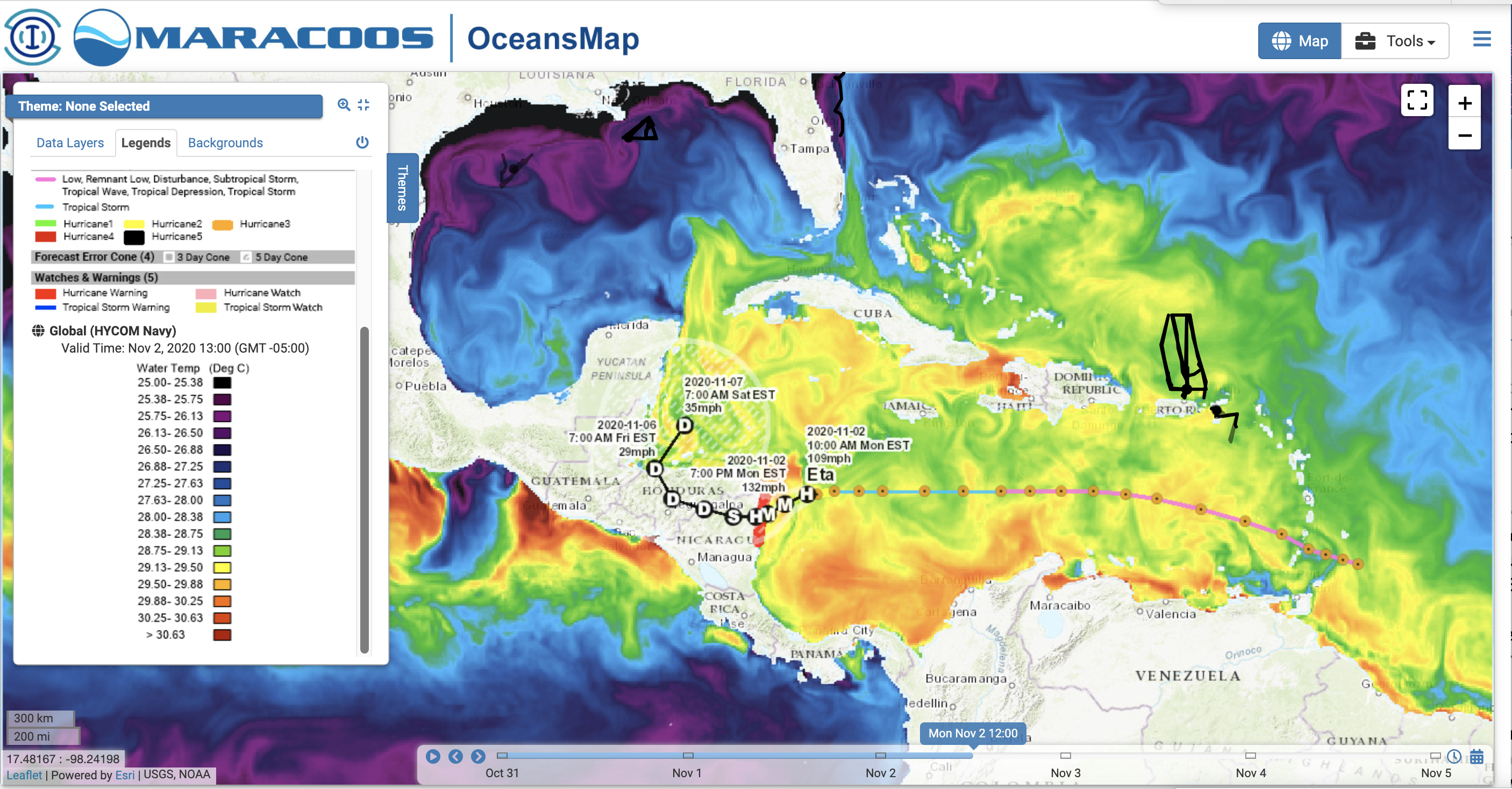
Step 3, check out the regional hurricane model forecast guidance:
Here is the most recent posting on the website for HWRF and HMON (intensity on upper right), with HMON a low Cat 3 and HWRF a high Cat 3. The short black line indicates that the best track is following the growth curves for HMON and HWRF. Official forecast in this forecast interval is taking Eta up to the edge of Cat 3.
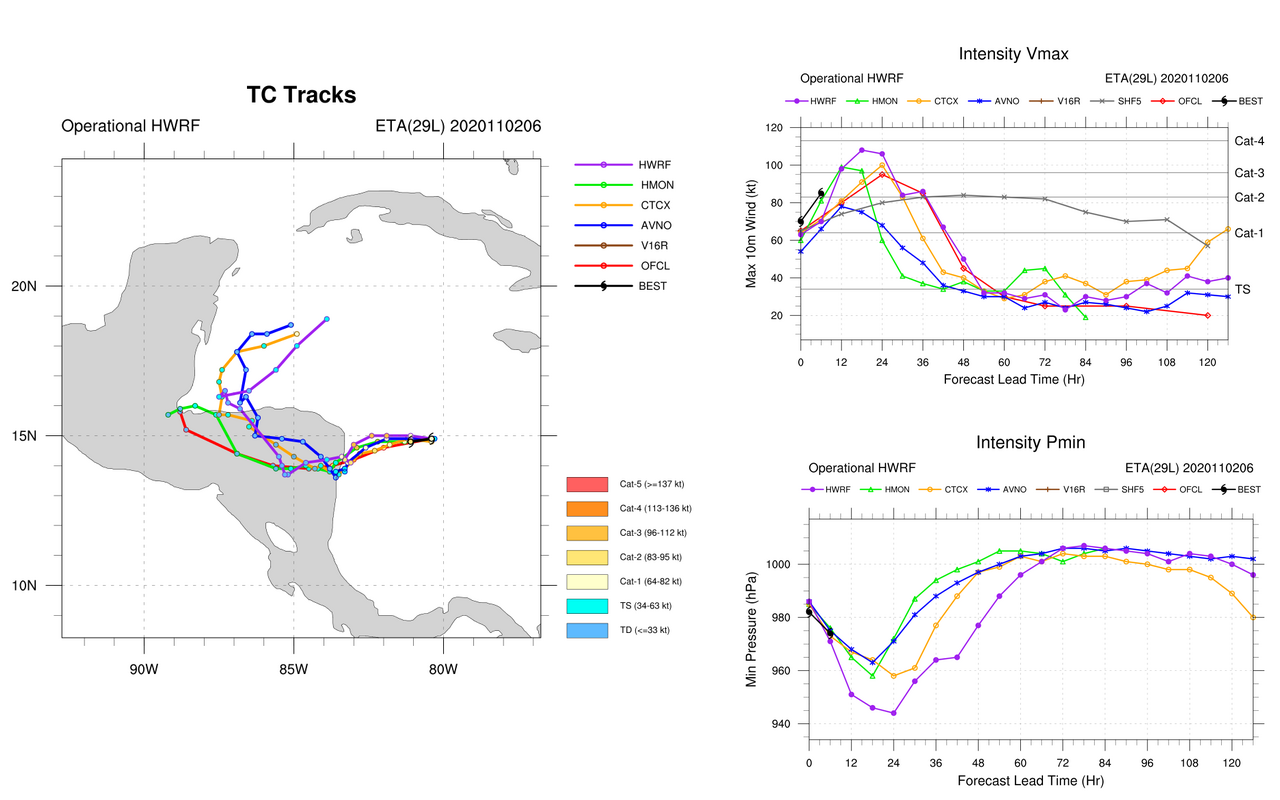
-
Tropical Storm Zeta
Posted on October 25th, 2020 No commentsThe 11 am National Hurricane Center discussion notes the importance of the ocean impacts on Zeta’s intensity in three locations.
- In the current location, the low shear and high ocean heat content in the western Caribbean favor intensification.
- As Zeta crosses the central Gulf, increasing shear and diminishing ocean heat content is expected to prevent intensification.
- As Zeta approaches the northern Gulf, the unfavorable ocean and atmospheric conditions could cause zeta to weaken beyond what is in the official forecast.
Below is the present regional guidance (HWRF in purple, HMON in green), and what we anticipate will evolve into future guidance, the experimental HAFS model (light blue). The tracks (left image) from these three models have converged since last night, and that makes them easier to compare. Zeta should be going over similar oceans in these models, something to check. On the top right is the intensity plot. The official intensity forecast (red) is above the model consensus. HAFS looks to be below the official forecast, keeping Zeta below hurricane strength as it approaches Yucatan. The operational models are showing the Zeta intensifying as it approaches Yucatan, with HMON going to Cat 3 and HWRF going to a high Cat 2. These models appear to be the ones that include the impact of the high ocean heat content in the western Gulf that the forecasters are saying favor intensification.
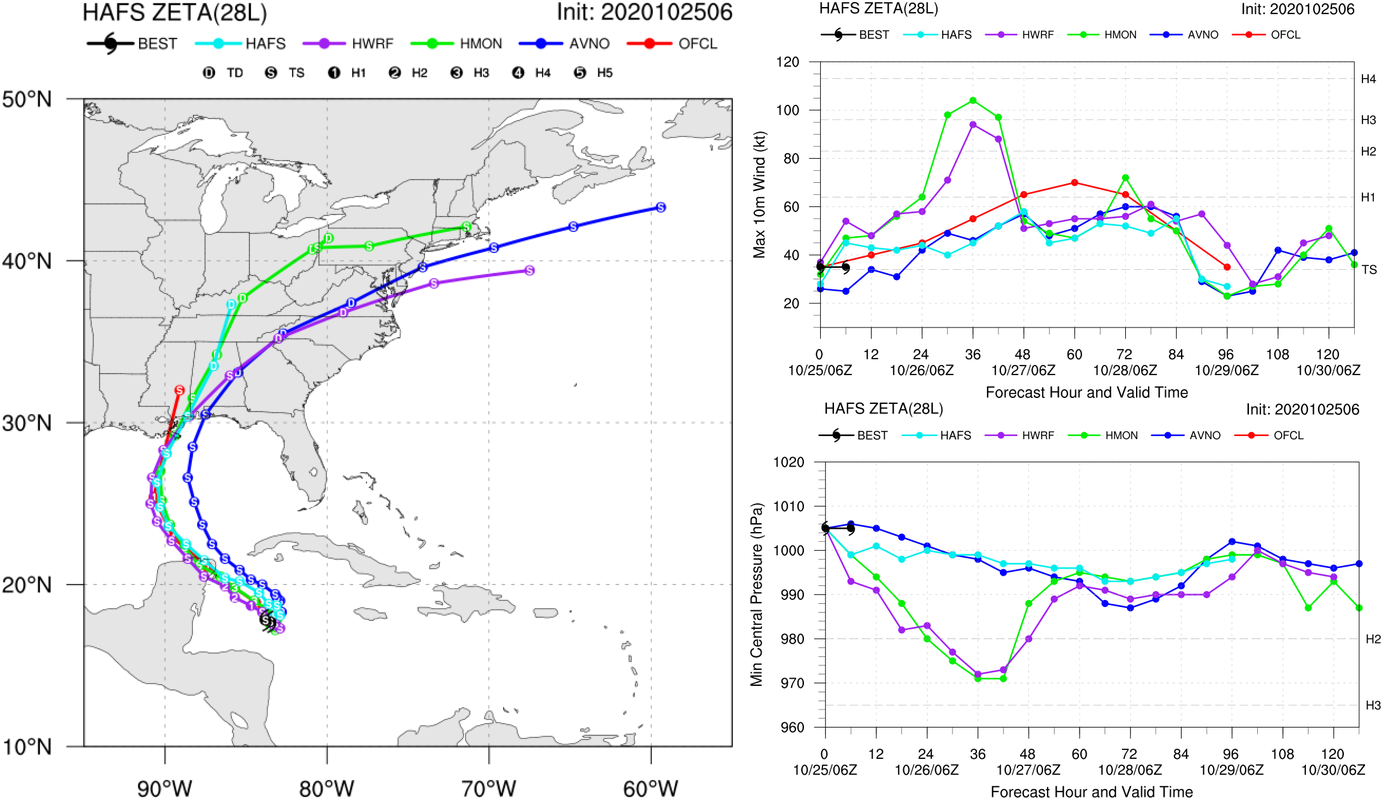
-
Tropical Depression Twenty-Eight
Posted on October 24th, 2020 No commentsThe 5 pm NHC forecast discussion reminds us that as this storm approaches the northern Gulf, the cooler shelf waters and the increasing wind shear will likely weaken this storm.
Lets take a look at those cooler temperatures by checking the Navy’s GOFS model SST. Here we see the official forecast track heading through the Yucatan Straits, with the cooler water way up on the shallow shelf of the northern Gulf. The green colors are still up around 27C, so the darker blues below 26c are really up by the coast.
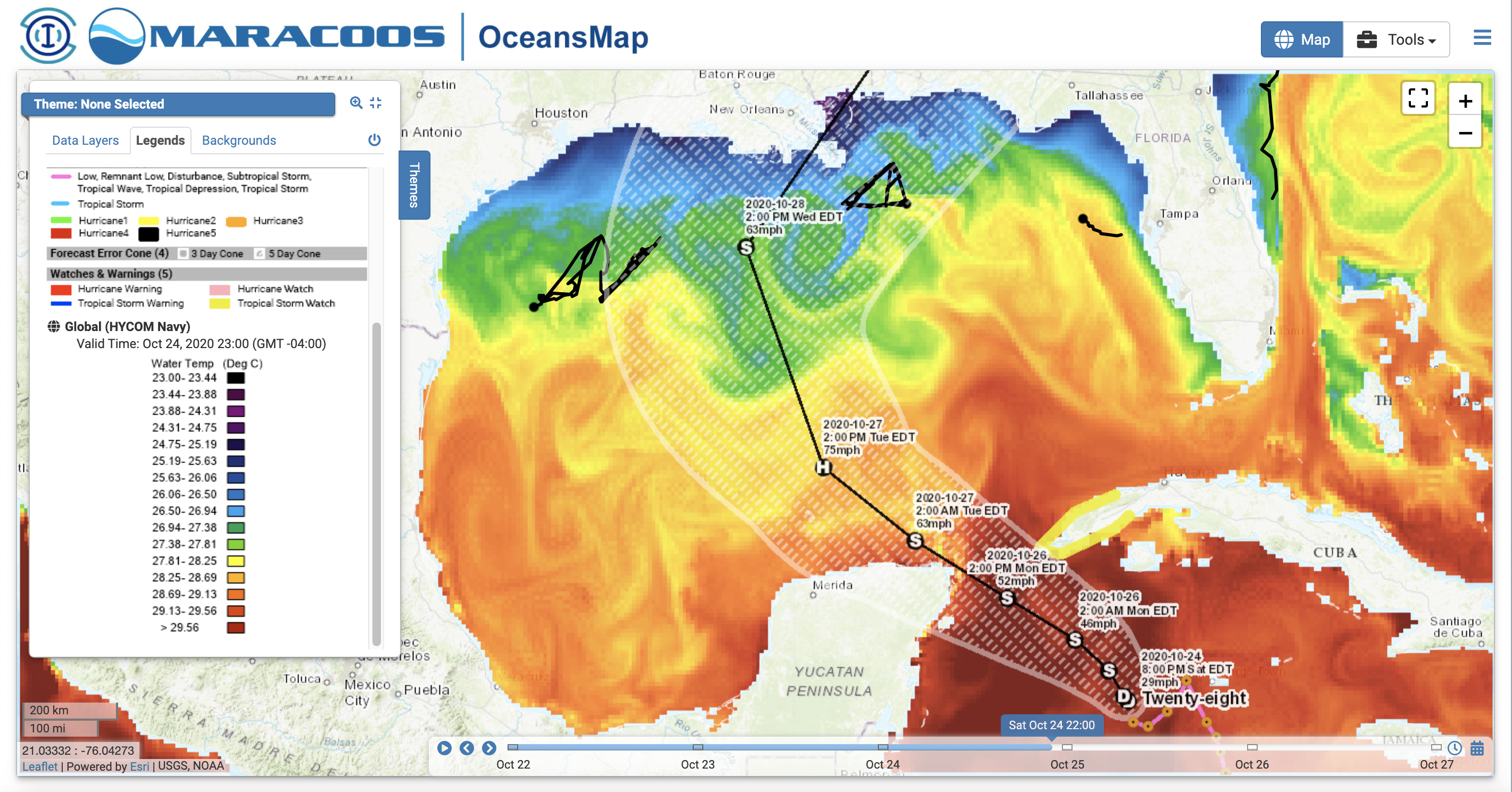
Now lets look at what the forecast guidance is telling us. HWRF and HMON, the two operational regional models, are hugging the right side of the cone, hitting western Cuba and tracking closer to the very warm (near 29C) waters of the Loop Current. Both of these models go to hurricane strength, with HMON hitting Cat 2 for a short period while the tracks are still very close (science question for the winter). If these tracks hold the storm will pass over NDBC’s glider SG601. The experimental HAFS model hugs the left side of the cone, tracking over Yucatan, and the cooler Mid-Gulf waters, remaining below hurricane strength throughout.
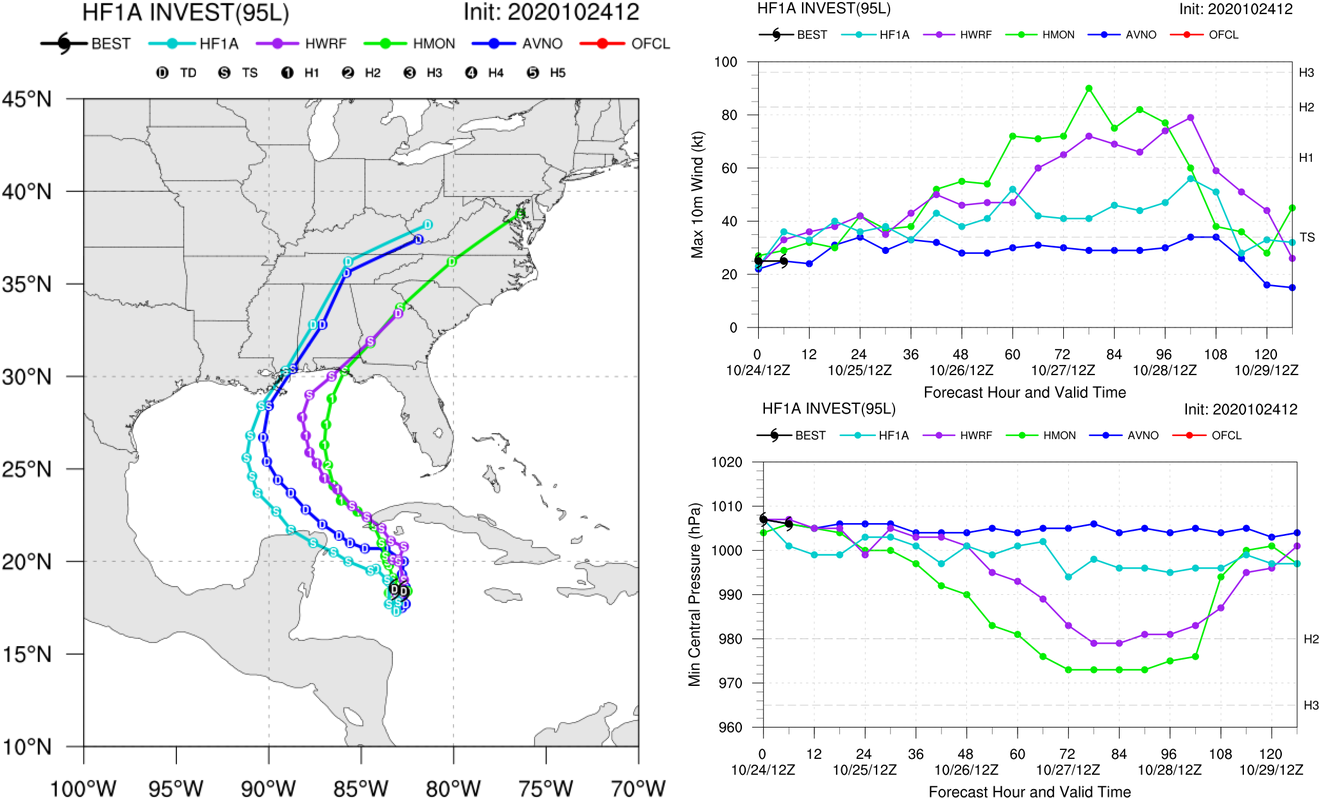
-
RUCOOL Updates: August & September 2020
Posted on October 14th, 2020 No commentsAs we transitioned from summer to a new school year, RUCOOL spun up virtual teaching for 7 fall semester courses and continued delivering on 28 research projects in a safe manner, enabled by Rutgers COVID-19 guidelines and our own documented procedures for remaining safe at sea and on shore.
State
- RU COOL faculty are involved in teaching 7 classes this Fall term. Courses include: Software Bootcamp, Ocean Observing, Ocean Modeling and Synthesis, Biological Oceanography, Waves and Sediment Transport, Undergraduate Ocean Observing, Freshmen Oceanography House.
- The first two Masters of Operational Oceanography students defended their theses in August! Julia Engdahl presented her talk on “Developing an Automated Analysis of Fish Migration Video Using Computer Vision Algorithms” in mid August, and in late August, Joe Anarumo presented on “An Open-Source Software Application for Drifter Trajectory Prediction in the Mid-Atlantic Bight”. They have already acquired jobs as oceanographic data analysts at NOAA CO-OPS and Sage Environmental consulting. Congrats to Joe and Julia on jobs well done!
- The second cohort of students have started their fall classes and thesis project. Students are participating in the operations of glider RU29 deployed in the Caribbean to help improve hurricane forecasting. Along with classes and research the students are learning to operate and make decisions about the glider deployment with daily ‘mission control’ meetings.
- Oscar Schofield was named Chair of the School of Environmental and Biological Sciences Chair Council.
- The RUCOOL Education team just completed an online program for 156 middle school kids through the ENIGMA project. ENIGMA strives to answer the question “Are we alone in the Universe?” To answer this fundamental question, scientists from Rutgers University and NASA are going all the way back to Earth’s beginning — back before there were people, dinosaurs, or even plants! The team also completed a new trailer for their research/education work.
- The Ørsted ECO-PAM glider, RU34, completed its first mission on August 26, after spending 28 days surveying the Ocean Wind offshore wind lease area. During that mission, it detected 4 tagged fish, and a fin whale on August 23. It was also at sea during Hurricane Isaias, contributing its data to the other hurricane glider data being taken at the time. The glider is expected to be redeployed in early October. (link: https://go.rutgers.edu/ECO-PAM).
- Through its ongoing work with NJ BPU, RUCOOL contributed to the New Jersey Offshore Wind Strategic Plan, issued by the State of New Jersey in September. (Link: https://www.nj.gov/bpu/pdf/Final_NJ_OWSP_9-9-20.pdf).
- Grace Saba worked alongside Jeanne Herb (Bloustein School) and graduate student Janine Barr (DMCS) to create a science-informed framework for the NJDEP’s overall ocean acidification initiative. They provided consultative science and planning and policy expertise over a compressed period of time for NJDEP to plan, research and design a comprehensive science-informed statewide ocean acidification initiative that may be included in the Coastal Resilience Plan under Gov. Murphy’s executive order 89.
National
- Oscar Schofield has been named Chair of the National Academy Sciences Study “Mid-Course Assessment of NSF progress on 2015 Strategic Vision for Antarctic and Southern Ocean Research”.
- Scott Glenn is chairing the NOAA Science Advisory Board (SAB) Environmental Information Services Working Group (EISWG) Task Team for the review of NOAA’s Response to Congress on the Hurricane Forecast Improvement Program. Draft report submitted for internal EISWG review.
- The RUCOOL Glider Team was involved either in deploying, piloting or recovering 11 gliders in August and September. Our partners in these deployments include the Univ. of Massachusetts Dartmouth, Virginia Institute of Marine Science, the University of Delaware, US Navy, and CARICOOS. During this time of year, the science focus is hurricanes predictability, however supports study of ocean pH, listening for whales, track fish and other tagged animals, and water quality in NJ coastal waters. Data from all of these gliders can be found here.
- RUCOOL maintains the high profile Hurricane Blog. It documents in real-time research findings for August and September focused on Isaias, Laura, Marco and Sally. The blog site is circulated by NOAA leadership and was distributed through the US IOOS Eyes-on-the-Ocean as a recommended data resource (https://rucool.marine.rutgers.edu/blog/category/hurricanes/).
- The RUCOOL Education Team completed an annual report for The Polar Literacy project. An online flipbook of the report is available here. The report includes evaluation results; a summary of the advice and guidance of their advisors; and our second year (2021) plans summarized, in light of the COVID-19 pandemic.
- Our Education Team also just completed a new Broader Impacts Wizard. The Wizard will help applicants develop a broader impacts plan that will satisfy the National Science Foundation Broader Impact requirements and fulfill their interest in communicating your science.
- The Data Labs Blog continues to feature articles on Ocean Observing Education, Python tutorials and examples of Labs. Additionally, the Education Team also has completed several new OOI Data Python Notebooks that involve students in data analysis through interactive widgets.
- MSC research partners from Rutgers University released a RFI for next generation sensor technology for Coast Guard Vessel Traffic Services (VTS). Collectively, the research team received responses from ten companies primarily focused on radar and camera technologies. The team will be reviewing the submissions this fall to assess how the technology will integrate into Coast Guard VTS operations. They will then model the sensor types based on the specifications supplied in the RFI and will make recommendations on the most promising technologies in a final report to the Coast Guard in late December.
- Scott Glenn attended the National Academies of Science, Engineering and Medicine (NASEM) Understanding Gulf Ocean Systems (UGOS) coordination meeting, reporting on the new HF Radar Quality Control procedures developed by the RUCOOL operations team that sets a new standard for the U.S. National HF Radar network.
International
- Oscar Schofield chaired the virtual science symposium focused on the West Antarctic Peninsula on behalf of the International Southern Ocean Observing System.
- Oscar Schofield was asked to Chair the virtual symposium of the Global Biogeochemical Argo program for G7 nations on behalf of the National Science Foundation and NASA.
- Scott Glenn was an invited speaker on Ocean Observing for the US-Indonesia (NOAA-BMKG) 3-day virtual collaboration meeting on climate and weather. BMKG Academy students are excellent candidates for the DMCS Masters in Operational Oceanography.
- Serving on the National Academies of Science, Engineering and Medicine (NASEM) Ocean Studies Board (OSB), Scott Glenn is working on the U.S. Committee for the U.N. Decade of Ocean Science for Sustainable Development to help launch the coordinated U.S. effort in October.
Student Awards
- Emily Slesinger was selected as a runner-up for the 2020 J. Frances Allen Scholarship Award. The scholarship was established in 1986 to honor Allen, who pioneered women’s involvement in the AFS and in the field of fisheries. The scholarship award comes with $2,500. Congratulations to Emily and her mentor, Grace Saba!
Newly Funded Research
- State of NJ Department of Environmental Protection, “Glider deployments for water quality monitoring”, Kohut ($84,464).
- National Science Foundation, “Supplemental Funding LTER Palmer, Antarctica (PAL): Land-Shelf-Ocean Connectivity, Ecosystem Resilience and Transformation in a Sea-Ice Influenced Pelagic Ecosystem”. This proposal was transferred to Rutgers to be the lead institution. Schofield, ($592,668).
- L3Harris (DARPA), “Timely Information for Maritime Engagements”, Glenn ($130,000).
- NOAA IOOS Alaska Ocean Observing System, “Autonomous Assessment of pH and Plankton in the Southeastern Gulf of Alaska”, Saba ($212,507).
- NSF Collaborative Research, “Developing a profiling glider pH sensor for high resolution coastal ocean acidification monitoring”, Saba ($164,347).
- New Jersey Department of Environmental Protection, “Creating a framework to support efforts of the New Jersey Coastal Management Program to address ocean acidification as an element of state coastal climate resilience planning”, Saba with Jeanne Herb ($56,985)
Papers Published: (**Current or Former Graduate Student or Postdoctoral Researchers)
- **Xu, Y., Miles, T., Oscar Schofield. O. 2020. Physical processes controlling chlorophyll-a variability on the Mid-Atlantic Bight along northeast United States. Journal of Marine Systems Volume 2012. DOI: 10.1016/j.jmarsys.2020.103433
- **Slesinger, E., Langan, J., Sullivan, B., Borkman, D., Smayda, T.. 2020. Multi-decadal (1972–2019) Mnemiopsis leidyi (Ctenophora) abundance patterns in Narragansett Bay, Rhode Island, USA. Journal of Plankton Research, fbaa035. DOI: 10.1093/plankt/fbaa035
- Barr, J., Bean, C., McDonnell, J. Aug 20, 2020. Strategies for Running a Successful Virtual Career Panel. Oceanography The Official Magazine of the Oceanography Society. DOI: 10.5670/oceanog.2020.220
- R. Lindeman, F. Straneo, N. J. Wilson, J. M. Toole, R. A. Krishfeld, N. L. Beaird , T. Kanzow J. Schaffer, 2020. Ocean circulation and variability beneath Nioghalvfjerdsbræ (79 North Glacier) ice tongue. Journal of Geophysical Research: Oceans. e2020JC016091. DOI: 10.1029/2020JC016091
- Friedland, K. D., Morse, R., Manning, J., Melrose, D., Miles, T., Goode, A., Brady, D., Kohut, J., Powell, E. 2020. Trends and change points in surface and bottom thermal environments of the US Northeast Continental Shelf Ecosystem. Fisheries Oceanography 29(5):396-414. DOI: 10.1111/fog.12485
RUCOOL Meetings & Conferences
- Though there were no in person meetings due to COVID, there were plenty of virtual meetings during the last two months: Ocean Hackweek Workshop, Offshore Wind Turbine Radar Interference Mitigation Webinar Series, Presentations to several local NJ Schools on various oceanography topics, Ocean Best Practices System Workshop IV, NJ PACT Stakeholder Meetings on Offshore Wind and Renewable Energy. New Jersey Water Monitoring Council Meeting, numerous recurrent hurricane meetings, including (a) national Hurricane Glider Picket Line coordination, (b) Extreme Event Ocean Observing Task Team (EEOOTT), (c) hurricane science meeting with NOAA Research Lab AOML, National Academies of Science, Engineering and Medicine (NASEM) Ocean Studies Board (OSB) Meetings.
-
Five Gliders in a Picket Line
Posted on October 8th, 2020 No commentsFirst a quick view of the northern Gulf the night before landfall of what looks to be a major hurricane. The image below shows the Sea Surface Temperature forecast for the Navy’s data assimilative Global Ocean Forecast System, a consistently high performing ocean model, definitely a good choice for the start of our U.S. hurricane forecast workflow. It nicely demonstrates the value of the hurricane glider picket line concept. These gliders have been deployed for weeks, feeding their data into the GOFS model everyday to do everything we can to put the best representation of the ocean we can underneath our best hurricane models. We have two Texas A&M Gliders on the west, two Navy gliders in the middle, one NOAA glider piloted by USM on the east. Multiple government, university and industry groups working together for the common purpose of generated the best forecasts possible. We call it “Distributed Autonomy”. With sampling distributed in space and time. With operations distributed between multiple shore labs. And sponsorhips distributed between different agencies. What we see below, the pre-storm conditions established by the GOFS model, is one reason why we deploy the Hurricane Glider Picket Line each year – to improve the hurricane models that we are using today to forecast this very storm.
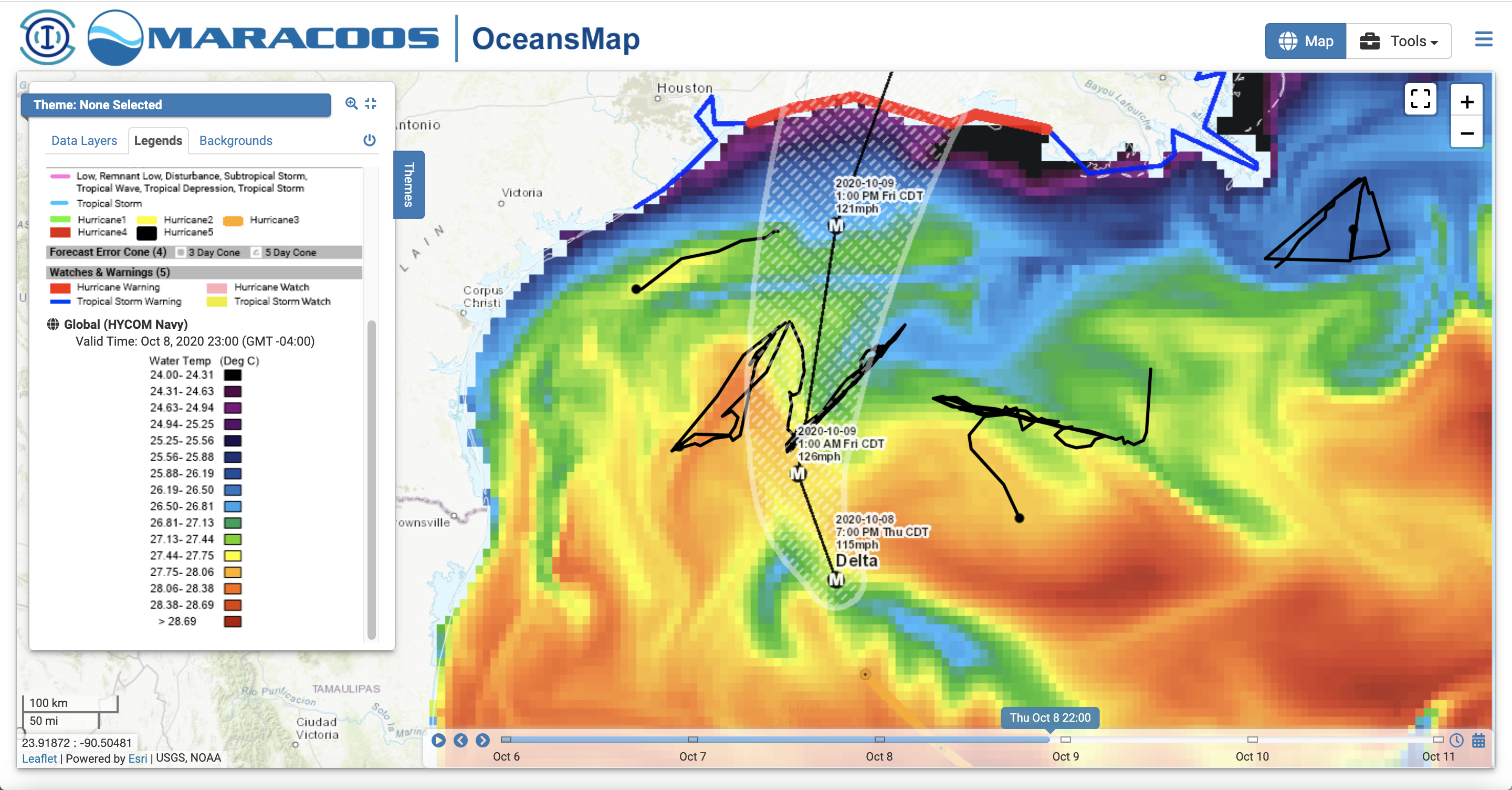
The second reason we deploy the glider picket line each year is shown below. It shows tomorrow’s GOFS forecast of the ocean currents, with the eye of Delta clearly visible a bit to the west of the official forecast, and the ocean current response to the downwelling-favorable winds (remember that blog entry from earlier in the week on upwelling versus downwelling?) along the LA-TX shelf, and we see the size of the storm. Four of the gliders will be directly in the thick of it, gathering the science data that will help us improve the hurricane models of the future. All that data to improve those future models is going to be gathered in the next 24 hours. By robots. No people have to go to sea. We are not overburdening the hurricane hunters and their flight crews. But we are there.
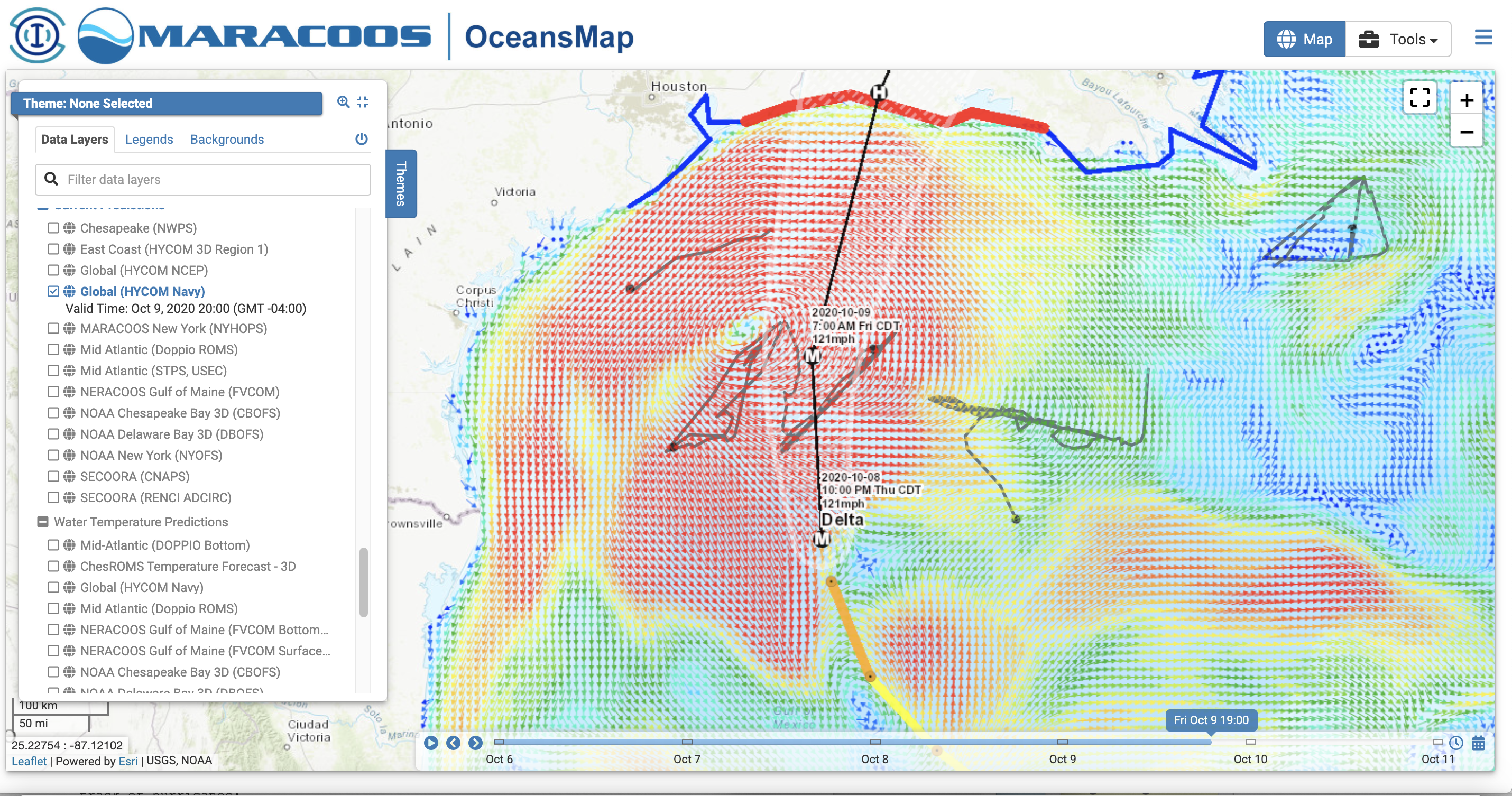
Stay safe Louisiana.
-
When Guidance and Forecasts Align
Posted on October 8th, 2020 No commentsAnother morning with remarkable agreement between the two operational regional models (HWRF and HMON) and the official NHC forecasts (red). Both models are skimming the bottom of the Cat 4 wind speed, and the official forecast is putting it in the middle of Cat 3. Not sure why the experimental HAFS model does not have the right initial condition. Something to check over the winter.
